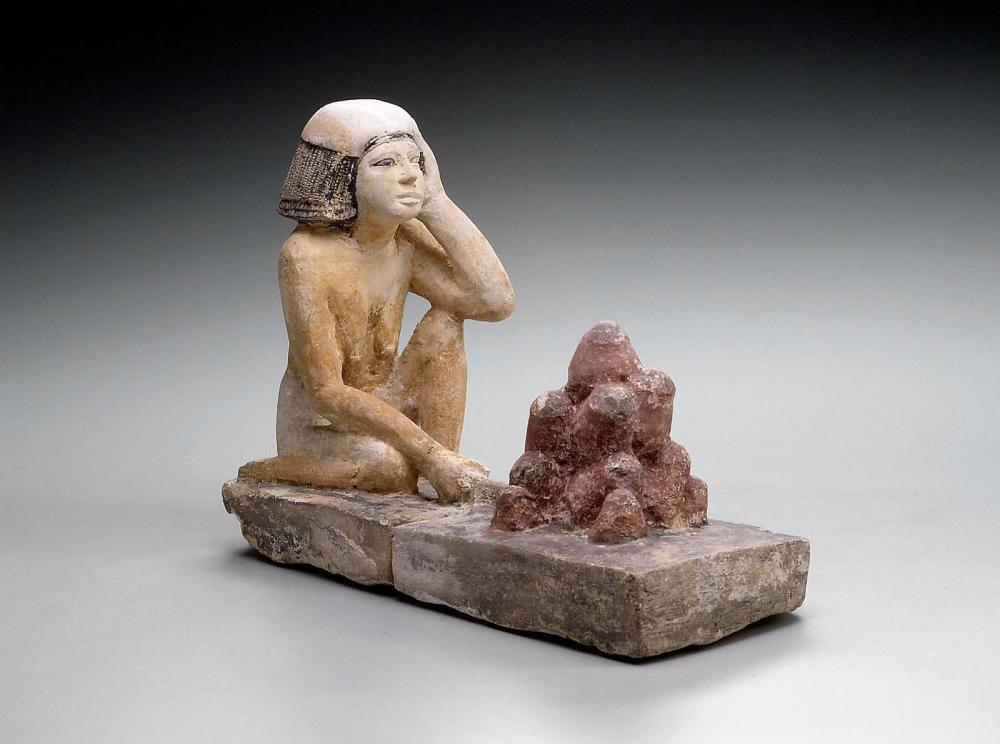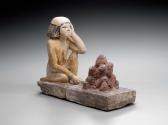Advanced Search
Serving statuette of a woman baking bread
Egyptian
Old Kingdom, Dynasty 5, reign of Niuserra
2420–2323 B.C.
Findspot: Egypt, Giza, Tomb G 2415
Medium/Technique
Limestone
Dimensions
Height x width x depth: 23.8 x 12.5 x 32 cm (9 3/8 x 4 15/16 x 12 5/8 in.)
Credit Line
Harvard University—Boston Museum of Fine Arts Expedition
Accession Number21.2600
CollectionsAncient Egypt, Nubia and the Near East
ClassificationsSculpture
Egyptian tombs sometimes contained small figures showing people engaged in ordinary, domestic tasks such as baking, weaving, brewing and so forth. Such statues, known as serving statues, were included in the tomb to ensure that the deceased would enjoy the benefits of the products and services represented. Additionally, servant statues communicate a great deal about Egyptian daily life.
This limestone figure shows a woman tending a fire heaped high with conical bread molds. With her left hand she seems to be shielding her face from the heat of the fire.
This limestone figure shows a woman tending a fire heaped high with conical bread molds. With her left hand she seems to be shielding her face from the heat of the fire.
DescriptionThe vast majority of Egyptian three-dimensional stone sculptures feature subjects in static and formal positions. By contrast, the figure here is engaged in action, and the artist has captured a single moment rather than a timeless eternity. A woman wearing only a skirt sits with one knee on the ground and the other up. True to life, her entire torso shifts slightly to the left as she pokes a fire with a rod in one hand and raises the other to shield herself from the glare. A kerchief protects her hair from sparks.
The woman is making bread in a manner frequently represented on contemporary tomb walls. The pile in front of her consists of coarse ceramic vessels that would be placed atop bowls filled with dough and buried in hot ash. The combination of heat from top and bottom baked the bread in just over an hour and a half. Bread and beer made from emmer wheat were staples of the ancient Egyptian diet.
This piece belongs to a category of sculptures termed "serving statues" in a recent scholarly study. Although such objects appear to depict humble servants, those that are inscribed bear the name of a member of the tomb owner's family or other dependent. Like this one, they were found in serdabs, sealed chambers that formed part of the tomb chapel, where family members left food offerings for the deceased. Through their useful service to the tomb owner, they too would be entitled to take part in the offerings and be sustained for eternity.
Apparently, when the artist carved this statue or shortly thereafter, it broke in half at the base. The ancient repair, a wooden peg connecting the two pieces, has held to this day.
The woman is making bread in a manner frequently represented on contemporary tomb walls. The pile in front of her consists of coarse ceramic vessels that would be placed atop bowls filled with dough and buried in hot ash. The combination of heat from top and bottom baked the bread in just over an hour and a half. Bread and beer made from emmer wheat were staples of the ancient Egyptian diet.
This piece belongs to a category of sculptures termed "serving statues" in a recent scholarly study. Although such objects appear to depict humble servants, those that are inscribed bear the name of a member of the tomb owner's family or other dependent. Like this one, they were found in serdabs, sealed chambers that formed part of the tomb chapel, where family members left food offerings for the deceased. Through their useful service to the tomb owner, they too would be entitled to take part in the offerings and be sustained for eternity.
Apparently, when the artist carved this statue or shortly thereafter, it broke in half at the base. The ancient repair, a wooden peg connecting the two pieces, has held to this day.
ProvenanceGiza, tomb G 2415. 1913: excavated by the Harvard University-Museum of Fine Arts Expedition; 1921: assigned to the MFA by the Egyptian government.
(Accession Date: January 1, 1921)
(Accession Date: January 1, 1921)







